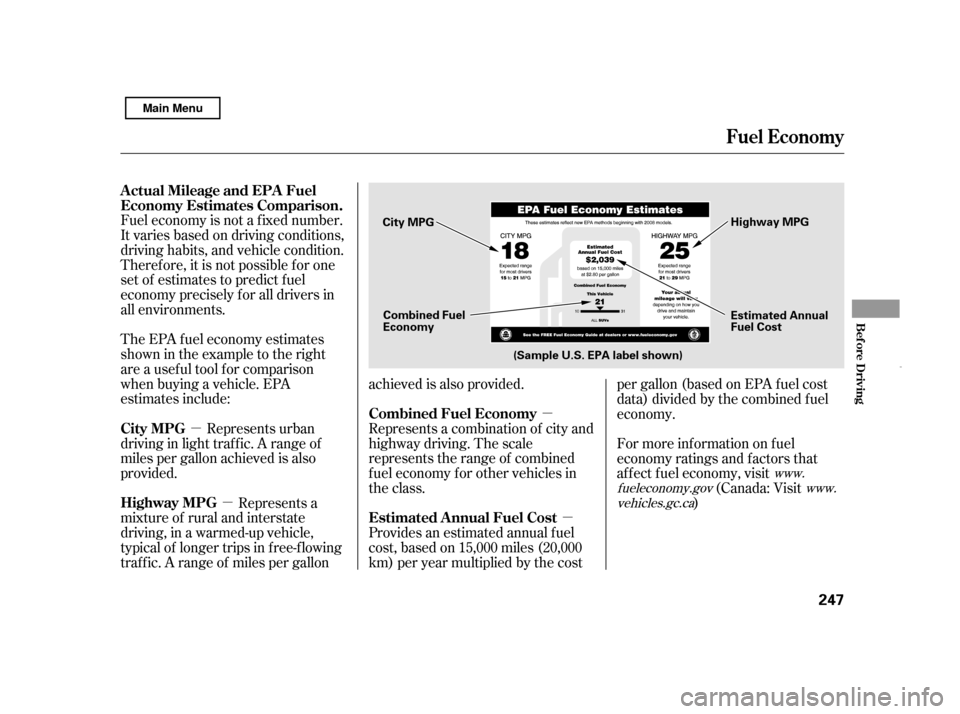Page 70 of 369

This shows the temperature of the
engine’s coolant. During normal
operation, the reading should be in
the middle of the gauge. In severe
driving conditions, such as very hot
weather or a long period of uphill
driving, the reading may reach near
the red mark. If it reaches the red
(Hot) mark, pull saf ely to the side of
theroad.Seepage for
instructions and precautions on
checking the engine’s cooling
system.
Every time you press the display
change button, the display changes
f rom the instant f uel economy to the
temperature gauge, or f rom the
temperature gauge to the instant f uel
economy.
The average fuel mileage and instant
f uel economy are shown with mpg or
l/100 km.
This display shows the current, or
instant f uel economy you are getting.
It shows the number of mpg or l/100
km.
Press and hold the display change
button until you hear a beep. The
speedometer, trip meter, average
f uel economy, and instant f uel
economy displays switch between
the selected miles or kilometers
readings.
321
Display Change Button
Temperature Gauge
Instant Fuel Economy
Gauges
66
Main Menu
Page 71 of 369

When either of the trip meters (trip
A or trip B) is displayed, your
vehicle’s average f uel economy since
you last reset that trip meter can be
shownontheinformationdisplay
(mpg or l/100km). This number is
updated once per 10 seconds. To see
the average f uel economy, press and
release the SEL/RESET button
repeatedly.This shows how much f uel you have.
It may show slightly more or less
than the actual amount.
The average f uel economy will be
reset when you reset the trip meter,
or if the vehicle’s battery goes dead
or is disconnected.
This meter shows the number of
miles or kilometers driven since you
last reset it.
There are two trip meters: TRIP A
and TRIP B. Switch between these
displays by pressing the SEL/
RESET button repeatedly.
Each trip meter works independently,
so you can keep track of two
dif f erent distances.
To reset a trip meter, display it, and
then press and hold the SEL/RESET
button until the number resets to‘‘0.0.’’ Fuel Gauge
T rip Meter A verage Fuel Economy
Gauges
Inst rument s and Cont rols
67
Avoid driving with an extremely low
f uel level. Running out of f uel could
cause the engine to misf ire, damaging
the catalytic converter.
Main Menu
Page 251 of 369

�µ�µ
�µ �µ
Fuel economy is not a f ixed number.
It varies based on driving conditions,
driving habits, and vehicle condition.
Theref ore, it is not possible f or one
set of estimates to predict f uel
economy precisely f or all drivers in
all environments.
Represents urban
driving in light traf f ic. A range of
miles per gallon achieved is also
provided.
The EPA f uel economy estimates
shownintheexampletotheright
are a usef ul tool f or comparison
when buying a vehicle. EPA
estimates include:
Represents a combination of city and
highway driving. The scale
represents the range of combined
f uel economy f or other vehicles in
the class.
Represents a
mixture of rural and interstate
driving, in a warmed-up vehicle,
typical of longer trips in f ree-f lowing
traf f ic. A range of miles per gallon achieved is also provided.
Provides an estimated annual f uel
cost, based on 15,000 miles (20,000
km) per year multiplied by the cost
pergallon(basedonEPAfuelcost
data) divided by the combined f uel
economy.
For more inf ormation on f uel
economy ratings and factors that
af f ect f uel economy, visit
(Canada: Visit
)
www.
fueleconomy.gov www. vehicles.gc.ca
Actual Mileage and EPA Fuel
Economy Estimates Comparison.
City MPG Combined Fuel Economy
Highway MPG Estimated Annual Fuel Cost
Fuel Economy
Bef ore Driving
247
Combined Fuel
Economy
(Sample U.S. EPA label shown) Estimated Annual
Fuel Cost
City MPG
Highway MPG
Main Menu